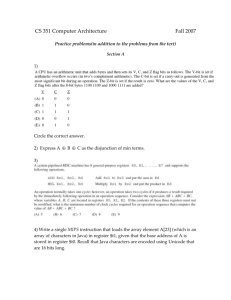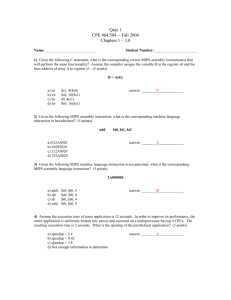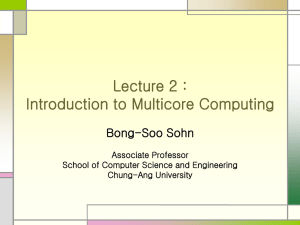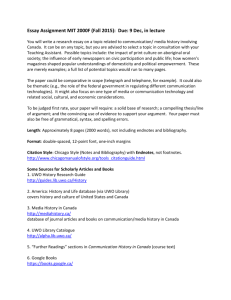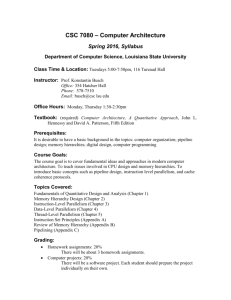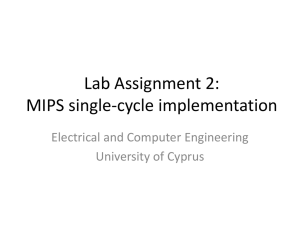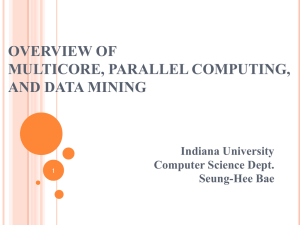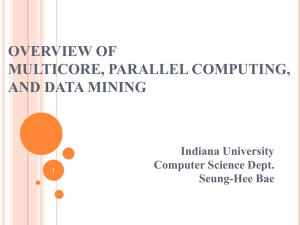CSE 431. Computer Architecture
advertisement
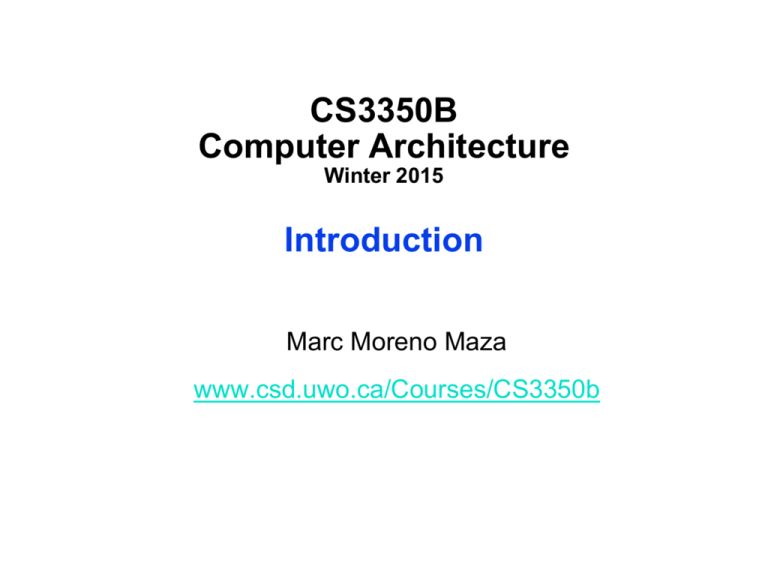
CS3350B Computer Architecture Winter 2015 Introduction Marc Moreno Maza www.csd.uwo.ca/Courses/CS3350b What is a computer? 2 What is a computer? 3 What is a computer? 4 What is a computer? 5 The Computer Revolution Progress in computer technology Underpinned by Moore’s Law Makes novel applications feasible Computers in automobiles Cell phones Human genome project World Wide Web Search Engines Computers are pervasive 6 Classes of Computers Personal computers General purpose, variety of software Subject to cost/performance tradeoff Server computers Network based High capacity, performance, reliability Range from small servers to building sized Supercomputers High-end scientific and engineering calculations Highest capability but represent a small fraction of the overall computer market Embedded computers Hidden as components of systems Stringent power/performance/cost constraints 7 The PostPC Era 8 The PostPC Era Personal Mobile Device (PMD) Battery operated Connects to the Internet Hundreds of dollars Smart phones, tablets, electronic glasses Cloud computing Warehouse Scale Computers (WSC) Software as a Service (SaaS) Portion of software run on a PMD and a portion run in the Cloud Amazon and Google 9 Components of a Computer Computer CPU Memory Devices Control Input Datapath Output Same components for all kinds of computer Desktop, server, embedded Below Your Program Application software Written in high-level language System software Compiler: translates HLL code to machine code Operating System: service code - Handling input/output - Managing memory and storage - Scheduling tasks & sharing resources Hardware Processor, memory, I/O controllers Levels of Program Code High-level language Level of abstraction closer to problem domain Provides for productivity and portability Assembly language Textual representation of instructions Hardware representation Binary digits (bits) Encoded instructions and data 12 Old School Machine Structures (Layers of Abstraction) Application (ex: browser) Compiler Software Hardware Operating System (Mac OSX) Assembler Processor Memory Instruction Set Architecture I/O system Datapath & Control Digital Design Circuit Design Transistors 13 New-School Machine Structures Software Parallel Requests Assigned to computer e.g., Search “Katz” Hardware Parallel Threads Assigned to core Harness Parallelism & Achieve High Performance Warehouse Scale Computer Smart Phone Computer e.g., Lookup, Ads Parallel Instructions >1 instruction @ one time Memory e.g., 5 pipelined instructions Input/Output Parallel Data >1 data item @ one time e.g., Add of 4 pairs of words … Core Hardware descriptions All gates working in parallel at same time Core (Cache) Instruction Unit(s) Core Functional Unit(s) A0+B0A1+B1A2+B2A3+B3 Main Memory Logic Gates Why do computers become so complicated? Pursuing performance! Eight Great Ideas Design for Moore’s Law Use abstraction to simplify design Make the common case fast Performance via parallelism Performance via pipelining Performance via prediction Hierarchy of memories Dependability via redundancy 15 Understanding Performance Algorithm Determines number of operations executed Programming Determine number of machine instructions executed per operation Processor and memory system Determine how fast instructions are executed I/O language, compiler, architecture system (including OS) Determines how fast I/O operations are executed 16 What You Will Learn How programs are translated into the machine language And how the hardware executes them The hardware/software interface What determines program performance And how it can be improved How hardware designers improve performance What is parallel processing 17 Course Topics 1. Introduction Machine structures: layers of abstraction Eight great ideas 2. Performance Metrics I CPU performance perf, a profiling tool 3. Hierarchical Memory The principle of locality DRAM and cache Cache misses Performance metrics II: memory performance and profiling Cache design and cache mapping techniques 18 Course Topics (cont’d) 4. MIPS Instruction Set Architecture (ISA) MIPS number representation MIPS instruction format, addressing modes and procedures SPIM assembler and simulator 5. Introduction to Logic Circuit Design Switches and transistors State circuits Combinational logic circuits Combinational logic blocks MIPS single cycle and multiple cycle CPU datapath and control 6. Instruction Level Parallelism Pipelining the MIPS ISA Pipelining hazards and solutions Multiple issue processors Loop unrolling, SSE 19 Course Topics (cont’d) 7. Multicore Architecture Multicore organization Memory consistency and cache coherence Thread level parallelism 8. Parallel Performance Metrics III: Parallelism and Profiling Amdahl’s law, Graham and Brent’s theorem Parallelism, Speedup Cilkview, a parallel performance analyzer 9. GPU Architecture Memory model Execution model: scheduling and synchronization 20 Student Evaluation Four assignments, each worth 10% of the final mark Four quizzes (key concepts, 30-minute in class), each worth 5% of the final mark. Assignment 1 (memory hierarchy), due on Friday, Jan. 23rd Assignment 2 (MIPS and circuits), due on Friday, Feb. 27th Assignment 3 (ILP), due on Friday, March 13th Assignment 4 (Multicore and TLP), due on Monday, April 6th Quiz 1 (CPU/memory performance metrics and hierarchical memory), beginning of class on Thursday, Jan. 22nd Quiz 2 (MIPS and logic circuits), Thursday, Feb. 26th Quiz 3 (ILP), Thursday, March 12th Quiz 4 (multicore and TLP), Thursday, April 2nd One final exam (covering all the course contents), worth 40% of the final mark 21 Recommended Text Book Patterson & Hennessy (2011), "Computer Organization and Design: The Hardware/Software Interface“, revised 4th edition or 5th edition. ISBN: 978-0-12-374750-1 Instructor: Marc Moreno Maza - email: moreno@csd.uwo.ca - Office Room: MC327 - Office hours: Tuesdays 2:30pm - 4:30pm Thursdays 1:30pm - 3:30pm Otherwise by appointment Teaching Assistants: Xiaohui Chen (xchen422@csd.uwo.ca) Ning Xie (nxie6@csd.uwo.ca) 22 Acknowledgements The lecturing slides of this course are adapted from the slides accompanied with the text book and the teaching materials posted on the WWW by other instructors who are teaching Computer Architecture courses. 23


